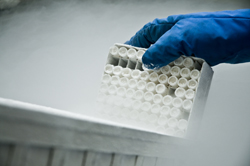Optimising plant cryopreservation
European scientists investigated procedures for preserving collections of plant germplasm and the genetic resources which they contain. Within the framework of the CRYMCEPT, they used cryopreservation for the long-term storage and preservation of germplasm material, which involved keeping plant cells or whole tissue at ultra-low temperatures. The technique halted all biological activity, including degradative reactions that lead to cell death. This was achieved by subjecting the plant material to osmotic or evaporative dehydration prior to cooling. CRYMCEPT project partners at the Institut de Recherche pour le Devéloppment in Montpellier, France studied the thermal behaviour of water. This study was undertaken using Differential scanning calorimetry (DSC) which provided the essential means to determine the best procedures for cryopreservation. Through the use of DSC the researchers ascertained the optimal exposure duration to Plant vitrification solution 2 which lowers water content, and furthermore alters the freezing behaviour of remaining water. They were also able to predict the optimal duration of desiccation over silica gel and drying in a sterile cabinet. For all three processes DSC was used to minimise the risk of damaging ice crystals formed in plant samples when prepared for cryopreservation. On the other hand, knowledge of the water behaviour can reduce the number of trial-and-error tests needed for developing cryopreservation procedures for new plant germplasm types. By reducing the time required for the optimisation of new cryopreservation protocols, the introduction of new endangered species in cryobanks of plant genetic resources will be accelerated. The conservation of plant species is essential for maintaining biodiversity and to the long-term success of the European agricultural and pharmaceutical industries and plant breeding programmes.







